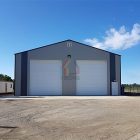The use of metal sandwich panels in prefabricated building partition
With the rapid development of the construction industry, the application of prefabricated building partition walls is becoming more and more widespread. As a new type of building material, metal sandwich panels have also been widely used in prefabricated building partition walls. This article will introduce the use of metal sandwich panels in prefabricated building partition walls, analyze its advantages, installation processes and application examples, and discuss its future development direction.
Introduction to metal sandwich panels
Metal sandwich panel is a composite material consisting of two layers of metal sheets filled with a lightweight core material. According to different core materials, metal sandwich panels can be divided into many types, such as polyurethane sandwich panels, silicate sandwich panels, phenolic sandwich panels, etc. The performance of metal sandwich panels depends on their constituent materials and processing techniques.

Advantages of metal sandwich panels in prefabricated building partition walls
1. Lightweight: The lightweight characteristics of metal sandwich panel reduce the weight of partition walls and facilitate transportation and installation.
2. Environmental protection: Metal sandwich panel can be recycled and reused, complying with environmental protection requirements.
3. Insulation: Metal sandwich panels have good thermal insulation properties and can meet energy-saving requirements.
4. Fire protection: Metal sandwich panels have good fire resistance and can improve the safety of buildings.
5. Sound insulation: Metal sandwich panels can effectively reduce noise and improve living comfort.
When installing metal sandwich panels in prefabricated building partition walls, follow these steps:
1. Preparation work: According to the design requirements, prepare the required metal sandwich panel, connectors, sealant and other materials. Check whether the construction site meets construction requirements.
2. Installation foundation: Install the foundation of the partition wall according to the design drawings. The foundation should be stable and level to provide reliable support for the partition wall.
3. Install the steel frame: According to the design requirements, install the steel frame of the partition wall. The steel frame should be kept horizontal, vertical and firmly connected.
4. Install the metal sandwich panel: Install the metal sandwich panel on the steel frame according to the design requirements, ensuring that the panel surface is flat and the connection is firm.
5. Install supports and fixings: Install supports and fixings on both sides of the metal sandwich panels to ensure the stability and load-bearing capacity of the partition wall.
6. Sealing: Sealing joints and gaps to ensure the air tightness and waterproof performance of the partition wall.

As a new type of building material, metal sandwich panels have broad application prospects in prefabricated building partition walls. Its lightweight, environmentally friendly, thermal insulation and other advantages as well as its beautiful and practical features make it one of the future development trends of the construction industry. With the continuous advancement of science and technology and the improvement of people’s requirements for construction, the application fields of metal sandwich panels will become more extensive. At the same time, we also need to continue to pay attention to and study its performance and optimization directions in practical applications to promote its sustainable development in the construction industry.












